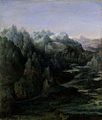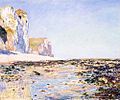Tokyo Fuji Art Museum
The Tokyo Fuji Art Museum ( Japanese 東京 富士 美術館 , Tōkyō Fuji bijutsukan ) is an art museum in Hachiōji , Tokyo Prefecture . The collection includes arts and crafts from different epochs and cultures, with works of art from Japan and Europe being the focus.
history
The museum was founded in 1983 by Daisaku Ikeda in Hachiōji, a suburb of Tokyo . Daisaku Ikeda is the president of Soka Gakkai International , a Buddhist denomination. According to the self-image of the religious community, the museum is intended to "spread peace, culture and education". For this purpose, the Sōka University , a concert association and an Institute for Oriental Philosophy were founded. The museum is located in a new building erected for this purpose in the early 1980s, which includes a sculpture garden. The museum shows around 4,000 objects in its permanent collection. In addition, it presents other works of art from its own holdings or from other museums in Germany and abroad in temporary exhibitions.
collection
The museum collection includes more than 25,000 objects. This includes objects as diverse as medallions, lacquer work, historical armor and weapons, ceramics, sculptures, paintings, prints and photographs. The exhibits in the ceramics collection are among the oldest works of art in the museum: In addition to old Chinese ceramics, there are also individual pieces from ancient Egypt, Greece and Persia. An example of the cultural exchange in antiquity is a Roman Hercules statue in the museum, which was based on a model by the Greek sculptor Lysipp . In addition to some examples of Japanese painting, the museum has one of the most extensive collections of European painting in Japan.
Japanese painting and printmaking
The various forms of expression of Japanese art are presented on an equal footing in the museum. In addition to armor, lacquer work and other handicrafts, examples of Japanese painting and color woodcuts can be seen here. The artists on display include Yusetsu Kaiho , of whom the museum has a battle painting , Shohaku Soga , which can be seen with a crane motif, and Kiitsu Suzuki with the god of wind and god of thunder and the moon with blossom branches . Other artists are z. B. Kitagawa Utamaro with the pressure on my oath , Tōshūsai Sharaku with the actor Ichikawa Ebizō IV. As Takemura Sadanoshin , and Utagawa Hiroshige with the works Garden of the Plum Trees in Kameido and Rain Showers over the Great Bridge in Atake . The best-known Japanese works of art in the museum include the pictures Thunderstorm Below the Summit , Clear Dawn with South Wind (known as Red Fuji ) and The Great Wave off Kanagawa from the series " 36 Views of Mount Fuji " by Katsushika Hokusai .
Old German painting
The collection area Old German Painting is particularly unusual for a museum in Asia. There are only a few, but top-class collector's items. This includes the mountain range created by Albrecht Altdorfer around 1530 as well as the portrait of a nobleman by Bernhard Strigel . Two portraits of the Saxon rulers by well-known artists complete this collection area. In addition to the portrait of Elector Friedrich III. von Sachsen by Michael Ostendorfer , the museum has a portrait of Elector Johann Friedrich I of Saxony by Lucas Cranach the Elder .
Italian painting
One of the earliest examples of Italian painting in the museum is the portrait of a procurator by the Venetian artist Giovanni Bellini from around 1507 . The museum is showing the portrait of Vittoria Colonna by Francesco Ubertini and the portrait of Giovanna Tornabuoni by Domenico Ghirlandaio . A scene from the life of Alexander the Great is the motif on a painting by Bernardo Strozzi , while a boy and a page by Paolo Veronese and a portrait of a collector by Jacopo Tintoretto .
Modern Italian painting begins in the museum with Pietro Benvenuti and his portrait of Napoleon from 1810, reading a letter . Examples of 19th century academic painting in Italy are the children 's portrait The Silk Divan by Michele Gordigiani and the painting Woman with Mandolin by Eugenio Zampighi from 1886 . The portrait of Dr. Paul Alexandre by Amedeo Modigliani , on the other hand, stands for an artistic new beginning.
Austrian painting
Austrian painting can only be seen in the museum with two examples. Both works date from the 19th century and show the artistic changes of this time. The family portrait of Karl Jakob Theodor Leybold from 1816 is still completely committed to classical painting, while Gustav Klimt's girl's head from 1880 marks the dawn of Austrian modernism.
Flemish and Dutch painting
Flemish painting is represented by big names in the museum, but mostly with less significant works in the museum. These include Landscape with Peasants on the Way to the Market by Jan Brueghel the Elder , Peasant Wedding and Hunters in the Snow by Pieter Brueghel the Younger and The Wedding of Constantine by Peter Paul Rubens . In addition, the museum has a feast by Frans II Francken and two very typical commissioned portraits by Anthony van Dyck ; the portrait of Amalia von Solms-Braunfels and the portrait of Anne Carr, Countess of Bedford .
The painting of the Netherlands can be seen in the museum with different genres. Thus, mythological themes can be found in the pictures Hercules and Omphale by Theodor van Thulden and Natan admonished King David von Arent de Gelder , portraits like girls with a doll by Govaert Flinck and portrait of a man by Frans Hals , as well as landscape pictures by Jan van Goyen , Willem de Heusch and Salomon van Ruysdael . Vincent van Gogh's farmhouse with a farmer's wife working in the fields from 1885 is in the tradition of these old Dutch models , while Lawrence Alma-Tadema's Roman studio from 1874 is more based on French academic painting of the 19th century.
English painting
Famous names can also be found in the collection of English paintings in the museum. There is a girl with her dog by Joshua Reynolds and The Prince Regent by Thomas Lawrence , a portrait of the later King George IV. The Helvoetsluys Museum is owned by William Turner ; the city of Utrecht, 64, going to sea and Seascape with a Squall Coming Up .
French painting
The museum's collection of French paintings is particularly extensive. The earliest works include two portraits by François Clouet . In addition to a portrait of King Heinrich II made in 1553, a portrait of a young rider is dated 1560. This is followed by a portrait of a flora by Ambroise Dubois from around 1600 . Other French baroque paintings are a flower still life by Jean Baptiste Monnoyer , Rinaldo and Armida by Nicolas Mignard , a forest landscape with a brook by Claude Lorrain and the smoker by Georges de la Tour . The subsequent Rococo is in the museum with the works Fertility by Jean-Honoré Fragonard , View of the Bridge with Sphinxes by Hubert Robert , Shipwreck on the rocky coast by Jean-Baptiste Pillement , The drawing class by Jean Siméon Chardin , the portrait of Antoine de la Roque by Antoine Watteau , three portraits of women by Jean-Marc Nattier and three typical Rococo pictures by François Boucher .
The portrait of Princess Jussupow by Élisabeth Vigée-Lebrun , the portrait of Louis-Eugène d'Etchegoyen by Antoine-Jean Gros , the portrait of Napoleon I and the portrait of Madame Bessieres by Robert Lefèvre as well as The Battle of Mont Thabor can be assigned to classicism by Jacques François Swebach . From the following generation of artists, the museum shows the landscape with goat and sheep by Théodore Géricault and cuirassier with a horse and Don Quixote in his library by Eugène Delacroix .
A small group of images is devoted to the Barbizon School . On display are herd of cattle by Constant Troyon , The Goose Girl and Portrait of a Man by Jean-François Millet , Coast near Villerville by Charles-François Daubigny and Jean-Baptiste Camille Corot 's paintings A pensive girl and Judith . Around the same time created an image of the series Meereswelle of Gustave Courbet and one for Henri Fantin-Latour typical Still Life with Grapes and peach . Examples of the highly successful 19th-century academic salon painting are Fishermen daughter of William Adolphe Bouguereau and Damenporträt toilet of Jules James Rougeron .
Impressionist painting is represented in this museum, as in numerous Japanese museums for Western art, with numerous top works. By Édouard Manet , the museum owns La Promenade, Portrait Mme Gamby and Pierre-Auguste Renoir works Young woman in red dress and Reading woman . There are also cows in the pasture, Louveciennes by Alfred Sisley , On the Terrace and Girls in Pink Dress by Berthe Morisot, as well as two landscapes and a view of London's Hyde Park by Camille Pissarro . The museum has three paintings by Claude Monet ; In addition to the ship on the beach and coast and the cliff of Pourville in the morning , the collection also includes a picture from the water lily series. Other pictures in this area of the collection include the farmhouse in Vaudreuil by Gustave Loiseau , ballet dancers by Edgar Degas and the girl in pink with a fan and portrait of Countess Morel d'Arleux with her son by the American Mary Cassatt, who lives in France .
From the following generations of artists it is mainly paintings from the first decades of the 20th century that found their way into the museum collection. These include Picnic in the Forest, Gerberoy and Alley at Dusk by Henri Le Sidaner , Rue Norvin; Montmartre and Moulin de la Galette by Maurice Utrillo , landscape with a view of the Citadel of Semur Semur-en-Auxois by Émile Bernard , the still life of flowers Anemone by Raoul Dufy and another bouquet by Moise Kisling , Albert Marquet a view of the port of Toulon , from Édouard Vuillard a woman with children and from Henri Martin the artist's garden , a view from the studio and a landscape.
Sculptures
The stock of European sculpture is much smaller than the museum's collection of paintings. One of the outstanding pieces here is a figure of Neptune by Giovanni Bologna from around 1560 . A child bust by Jean-Baptiste Lemoyne is around 200 years younger . This is followed by a Napoleon sculpture by Charles-Louis Corbet from around 1798 . The sculpture Education by Charles Cordier was created around 1882 . The museum also has two sculptures by Auguste Rodin , three female sculptures by Aristide Maillol and five works by Antoine Bourdelle from the early 20th century .
literature
- Künstlerhaus Wien (Ed.): Masterpieces of Japanese art from the Tokyo Fuji Art Museum . Künstlerhaus Wien, Vienna 1992, ISBN 3-900926-09-3 .
Web links
- Tokyo Fuji Art Museum website (Japanese, English)
Coordinates: 35 ° 41 ′ 11.2 " N , 139 ° 19 ′ 46.2" E



















